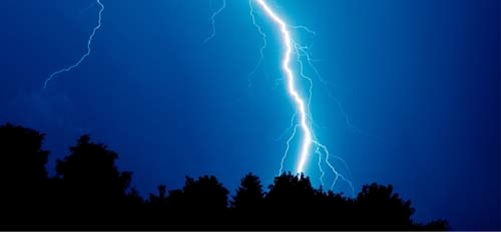What Everyone Ought to Know About Golf and Lightning
AUGUST 3, 2015 | BY ALLISON DOYLE
While lightning might be beautiful to see in the sky, thunderstorms are no joke, especially out on the golf course. Golf is one sport that is not necessarily hindered by inclement weather, and some golfers pride themselves on being “all weather" players; but before you continue playing when a storm starts, please consider these facts about golf and lightning, and learn what you should do if you find yourself caught in a thunderstorm out on the golf course.
According to ready.gov’s section on “Thunderstorms & Lightning,” lightning continues to be one of the top three storm-related causes of fatality in the U.S, causing 51 deaths on average per year.
Lightning seeks the path of least resistance on its way to the ground, and the human body is an extremely good conductor due to the body’s large percentage of water. While metal is a better conductor (lightning travels easily— and over long distances—through metal objects such as fences and railroad tracks), if you live in an area with frequent thunderstorms (and enjoy playing golf even in weather), then you are at risk.
Many golf courses in areas known for thunderstorms have storm warning systems such as sirens installed to warn golfers if a thunderstorm is approaching. While in a U.S. National Oceanic Administration 30-year-period study, it was found that golfing only accounted for 4% of lightning strike fatalities (as compared to 13% under trees and 8% around water), it's still a good idea to play it safe.
Here are some precautions you can take if you are caught on the golf course in a lightning storm:
- Avoid open high ground and isolated large trees
- Avoid water (swimming pools, lakes, ponds, rivers), beaches, and boats
- Seek shelter inside a building or within a nearby automobile, but NOT a convertible or golf cart
- Stay away from doors, windows, and metal objects (such as pipes, faucets, or metal fencing)
- Avoid contact with electrical devices or metal (including some golf clubs, umbrellas, golf carts, etc.)
- Do not lean against concrete walls
If you are in an open area, best advice: go to a low place such as a ravine or valley. Be alert for flash floods, and try to reach the indoors whenever possible.
If you are in a forest or heavily tree-covered area, best advice: seek shelter in a low area under a thick growth of small trees
If you begin to feel a tingling sensation on your hair or skin, squat in a baseball catcher’s position with your arms
around your legs.
Some facts you might not know about lightning:
- Air in a lightning strike can be heated up to 50,000 degrees Fahrenheit. The rapid heating of the air is what produces the shockwave that results in thunder
- Lightning often strikes outside of heavy rain, and may occur as far as 10 miles away from any rainfall
- Most lightning incidents occur when people are caught outdoors in the summer months during the afternoon and evening (between 2:00-6:00 p.m.)
- A ground strike can produce somewhere between 100 million to one billion volts of electricity
- The length of a cloud-to-ground lightning strike can range from two miles to 10.
- Lightning strike victims, contrary to what some movies portray, carry no post-strike electrical charge, and should be assisted immediately.